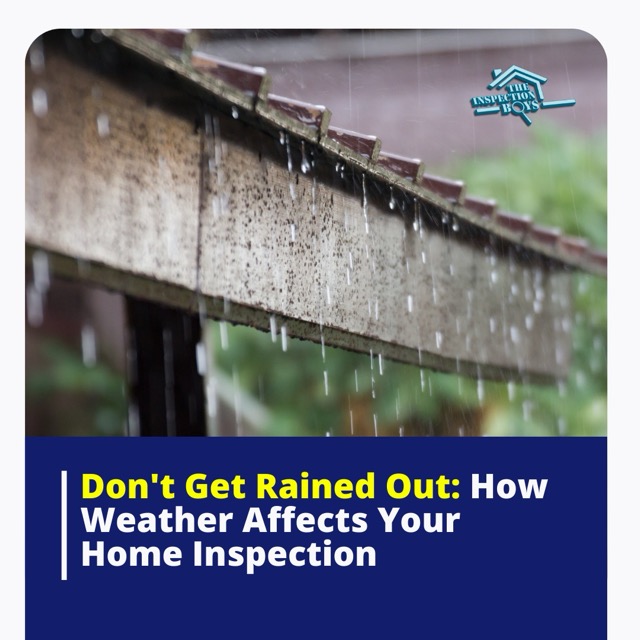So you’ve found your dream house and booked a home inspection – a crucial step before finalizing the purchase. But wait! There’s a chance of rain on inspection day. Should you reschedule? Weather can significantly impact a home inspection, and understanding how is key to getting the most accurate assessment of the property.
Rain Reveals, Rain Conceals
Heavy rain can be a blessing in disguise for a home inspection. Leaks that might go unnoticed in dry weather become readily apparent with rainwater intrusion. Home inspectors can identify issues with roof flashing, drainage systems, and foundation cracks that allow water seepage. For instance, a leaky roof or basement seepage becomes visible only during rainfall, providing a realistic picture of potential water damage.
However, heavy rain also presents challenges. Slippery surfaces can pose safety hazards for home inspectors, making it difficult to thoroughly examine the roof or climb on decks. Additionally, wetness can obscure signs of underlying problems like damaged siding or peeling paint. In extreme cases, areas prone to flooding might become inaccessible, thus limiting the inspection scope.
Shining a Light on Winter Woes
Snow and ice pose unique challenges during home inspections. While snow accumulation can highlight potential roof leaks by revealing ice dams, it can also mask underlying issues like damaged shingles or structural problems. For example, ice dams can indicate poor insulation or ventilation in the attic. However, snow cover might hide broken shingles or compromised roof structures that would be visible in other seasons.
Similarly, frozen pipes or malfunctioning heating systems might go undetected during a winter inspection. It’s essential to understand that certain issues like drafty windows or insufficient insulation become more apparent during cold weather, offering insights into the home’s energy efficiency.
Home inspectors can still assess the home’s insulation and ventilation during cold weather. Drafty windows and poor insulation become more apparent when the temperature dips, providing an opportunity to spot inefficiencies that might lead to higher heating costs.
Heat Waves and Hidden Issues
Extreme heat can also affect a home inspection. HVAC systems are pushed to their limits during hot weather, making it a good time to assess their functionality. Home inspectors can identify problems like low refrigerant levels or clogged air filters that might go unnoticed in cooler weather. A system’s inability to maintain a comfortable indoor temperature can indicate potential malfunctions.
However, extreme heat can also make it difficult to accurately gauge the efficiency of the cooling system. Additionally, hot attic spaces might pose safety concerns for home inspectors, limiting their ability to thoroughly inspect these areas.
High Winds: A Blustery Inspection
Strong winds can be beneficial during a home inspection by revealing vulnerabilities in the home’s exterior. Home inspectors can check for loose shingles, damaged siding, and gaps around windows and doors that could allow water intrusion. Windy conditions can expose areas where the structure might be susceptible to drafts or pest infestations.
However, high winds can also make it unsafe for home inspectors to walk on the roof or climb on precarious structures. In some cases, wind gusts can cause immediate damage that complicates the inspection process, such as dislodging roof tiles or causing branches to fall and obstruct inspection areas.
Making the Most of Your Inspection, Rain or Shine
So, what can you do to ensure a thorough inspection regardless of the weather? Here are some tips:
- Communicate with your licensed home inspector: Discuss the weather forecast and potential limitations of the inspection. An experienced inspector can provide insights on how weather might affect their ability to access certain areas and what alternate plans might be necessary.
- Prepare the property: Clear snow and ice from walkways and decks for safe access. If possible, move furniture away from walls for a more comprehensive inspection. Ensuring safe and easy access can help the inspector perform a more thorough job.
- Be flexible: If the weather poses safety concerns, consider rescheduling the inspection. While it might be inconvenient, ensuring a safe and comprehensive inspection is crucial.
- Ask questions: Don’t hesitate to ask your licensed home inspector about any concerns you have, especially if weather conditions limit their ability to examine specific areas. Understanding the limitations and possible implications of weather conditions can help you make informed decisions.
By understanding the impact of weather and taking proactive steps, you can ensure your home inspection provides valuable insights into the condition of your potential new home, rain or shine. Effective communication with your inspector and proper preparation can mitigate many weather-related challenges, ensuring you receive a comprehensive assessment of the property’s condition.
Conclusion
While weather can pose certain challenges to a home inspection, it can also reveal crucial information about the property. Rain can expose leaks, snow can highlight insulation issues, heat can test HVAC systems, and wind can reveal exterior vulnerabilities. By being aware of these factors and preparing accordingly, you can ensure your home inspection is as thorough and informative as possible.
Whether you are a buyer, seller, or homeowner, understanding how weather impacts a home inspection can help you make better decisions and ensure your property is in good condition. Licensed home inspectors and home inspection services play a vital role in this process, providing the expertise needed to navigate these weather-related challenges effectively.

